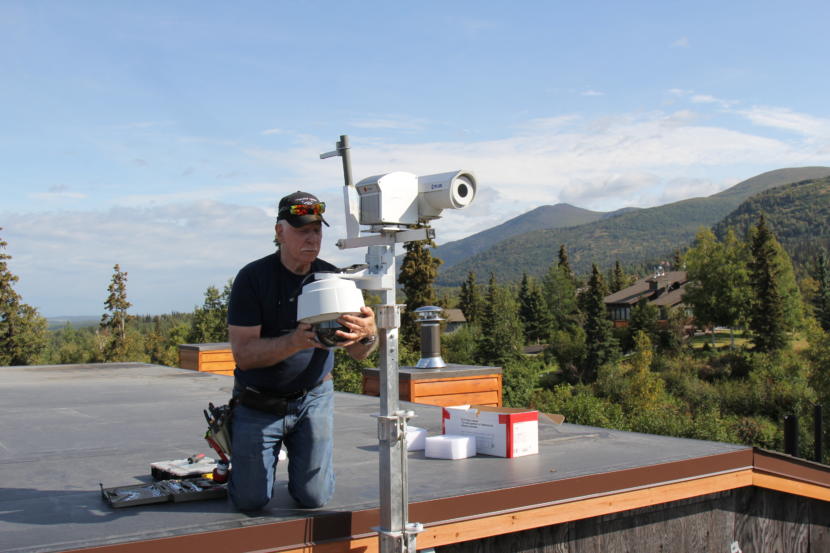
In mid-August, Anchorage forester John See stood on the roof of a home in the city’s Stuckagain Heights neighborhood.
“We’re going day by day now,” See said, looking out over the Anchorage Bowl. “When we hit these lower humidity, higher temperature days like we’re expecting today and through the weekend, those are kind of the worst case scenario.”
See’s words were prescient. That weekend, major wildfires ignited north and south of Anchorage, consuming tens of thousands of acres and, in the case of the McKinley Fire, over 50 homes.
Trying to prevent another, similar disaster is why See was on the roof of the Stuckagain Heights home. He was overseeing the installation of a specialized monitoring device, meant to help the Anchorage Fire Department respond to fires faster.
The device is called a thermography camera, and it resembles a security camera. It and the accompanying system are designed to locate and analyze the telltale signs of a wildfire, said John Parker, president of Integrated Robotics Imaging Systems: “Persistent heat sources, heat sources that grow over time, moving heat sources and heat sources that have the common elements of a fire.”
During the testing phase, the camera will sweep forested areas from Tudor Road to the north and Service High School to the south.
When the camera detects something suspicious, it will send a signal to the Anchorage Fire Department. First, the potential fire spot will show up on a screen in the dispatch center, indicated by a green square.
“Once it determines that it actually is a fire, that square turns bright red and starts strobing,” Parker explained.
Then, an alarm will sound and responders will be given a GPS location for the fire. A different camera will zoom in and and show visual image of what’s happening on the ground.
The whole setup is not exactly cheap — the thermography camera alone is worth $12,000. But this is a pilot project, Parker said, so he is installing the system at no cost to the city. According to Parker, The Eyak Corporation, the village corporation for Cordova, is helping fund the pilot project in hopes that it could ultimately be used for wildfire detection in rural Alaska.
The thermography camera in Stuckagain Heights is one of two now installed in the city; the other is at the Anchorage Fire Department. The system isn’t operational yet, but the department hopes to finish setting it up and begin testing this fall.
See with the Anchorage Fire Department said if it works, one of the main benefits is its ability to show exactly where the fire is. That’s because sometimes people who call in to report smoke rising from the forest have a hard time explaining its location, making it take longer for firefighters to get there.
“The kind of description the dispatchers get is, ‘well, it’s somewhere east of Elmore Road, and it’s south of Tudor .. I’m not sure exactly where it’s at,’” See said.
The cameras, he added, are “definitely going to save critical time”
See also said they could help the fire department figure out how aggressively they need to go after a fire. If they show an incident that is less of a risk, it could save resources. On the other hand, if the fire looks like the real deal, “it’ll allow us to immediately contact Division of Forestry and get the assistance we need…the air tankers, helicopters with bucket drops and the crews ordered up to come help us,” See said.
According to See, small fires in Anchorage are relatively common — so far, no major wildfire disasters, but there have been some near misses. The hope is that these cameras help the city avoid a bad incident in the future.
Chris Northcut owns the house where the camera is being installed. Northcut used to work in fire response and happens to live in a perfect spot for the camera, so he volunteered his roof for the project.
“The Anchorage hillside is a tinderbox. And the hotter the temperatures get and the longer that we get and the drier it gets, the worse it could get,” Northcut said.
Will the new system provide a bit more peace of mind to someone living in the middle of that ‘tinderbox?’
“Lots of peace of mind,” Northcut said.